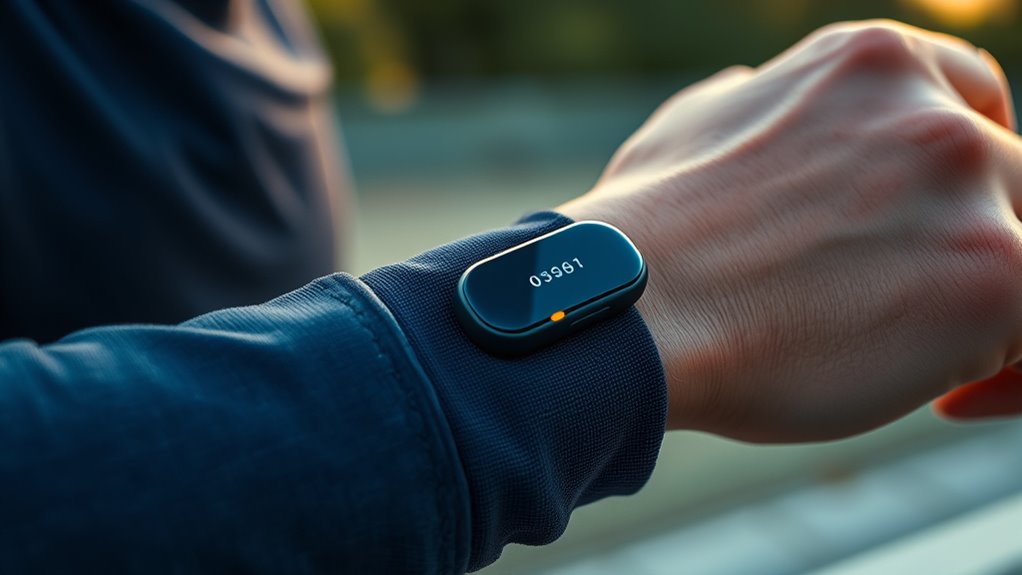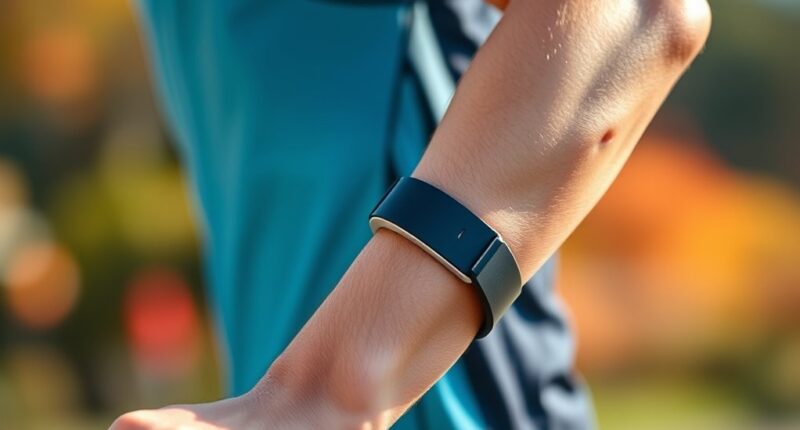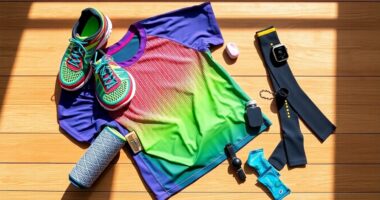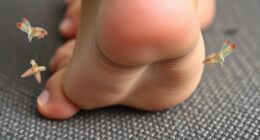If you’re looking for the best optical forearm HR sensors for runners in 2025, I’ve found devices that combine comfort, accuracy, and durability. Models like Polar Verity Sense and Garmin HRM-Dual stand out for their reliable readings and versatile connectivity. Other options, such as COOSPO HW9 and Moofit, offer excellent performance and long battery life. Keep in mind factors like fit, water resistance, and compatibility. If you continue, you’ll discover which sensors fit your needs best.
Key Takeaways
- Prioritize lightweight, adjustable, and breathable designs like Polar Verity Sense and Garmin HRM-Dual for comfort during long runs.
- Ensure sensors support Bluetooth and ANT+ for broad device compatibility and seamless integration with fitness apps.
- Choose devices with proven high accuracy and reliable real-time data, such as COOSPO HW9 and Magene H64.
- Opt for models with long battery life, rechargeable options, and quick charging to support extended training sessions.
- Consider water resistance and multi-sport features, like swimming capability, for versatile use in various running and outdoor conditions.
Polar Verity Sense Heart Rate Monitor Armband
If you’re a runner seeking a comfortable, unobtrusive way to monitor your heart rate without the hassle of chest straps, the Polar Verity Sense Heart Rate Monitor Armband is an excellent choice. Weighing only 19 grams, it offers a snug, secure fit on your upper or lower arm, even during vigorous activity. Its compact, lightweight design makes it almost invisible under clothing or clipped to goggles for swimming. Compatible with Bluetooth and ANT+, it easily connects to your devices, providing real-time data and recording sessions. Despite some software hiccups, users praise its accuracy, comfort, and versatility, making it a reliable alternative to traditional heart rate monitors.
Best For: runners and athletes seeking a comfortable, unobtrusive heart rate monitor that offers reliable tracking during various activities, including swimming.
Pros:
- Lightweight and comfortable design suitable for extended wear and vigorous movements
- Compatible with both Bluetooth and ANT+ for versatile device connectivity
- Accurate heart rate readings and versatile placement options, including under swim goggles
Cons:
- Software ecosystem (Polar Beat and Polar Flow apps) can be unreliable, leading to disconnections and incomplete data
- Shorter battery life compared to traditional chest straps, limiting continuous use during multi-day activities
- Limited features for comprehensive daily activity tracking and no direct display or on-device metrics
Garmin 010-12883-00 HRM-Dual Heart Rate Monitor
The Garmin 010-12883-00 HRM-Dual Heart Rate Monitor stands out as an excellent choice for runners who need reliable, real-time heart rate data across multiple devices. Its soft, adjustable strap is comfortable and washable, with a replaceable battery lasting up to 3.5 years. Compatible with smartphones, Garmin devices, and fitness equipment supporting ANT+ and Bluetooth LE, it delivers instant, accurate readings during various activities. Users appreciate its ease of use, reliable connection, and multi-device functionality. While some report odor issues and occasional signal drops over time, regular cleaning and proper placement help maintain performance, making it a dependable option for consistent heart rate monitoring.
Best For: athletes and fitness enthusiasts seeking a reliable, multi-device compatible heart rate monitor for running, cycling, rowing, and gym workouts.
Pros:
- Accurate, real-time heart rate data with easy automatic connection
- Long-lasting, replaceable battery (up to 3.5 years)
- Compatible with a wide range of devices supporting ANT+ and Bluetooth LE
Cons:
- Potential odor buildup and performance degradation after a few months
- Occasional signal drops or inconsistent readings during use
- Some units may experience reliability issues over time, requiring replacement
COOSPO HW9 Bluetooth Heart Rate Monitor Armband
For runners seeking accurate and comfortable heart rate monitoring, the COOSPO HW9 Bluetooth Heart Rate Monitor Armband stands out with its optical sensor and adjustable, breathable design. It delivers precise measurements with a ±1 BPM monitoring error, making it reliable for training and calorie tracking. The device features a 5-color LED to easily identify your Heart Rate Zone and supports HRV measurement for deeper health insights. Its soft, breathable band fits comfortably during various activities like running and cycling. Compatible with Bluetooth 5.0 and ANT+, it connects seamlessly with fitness devices and apps. Plus, its long-lasting battery and safety alerts make it a versatile choice for serious runners.
Best For: serious runners and fitness enthusiasts seeking accurate, comfortable, and customizable heart rate monitoring during various activities.
Pros:
- Precise heart rate measurement with a ±1 BPM accuracy, ensuring reliable data for training.
- Comfortable, adjustable, and breathable armband design suitable for prolonged use and multiple sports.
- Supports dual connectivity via Bluetooth 5.0 and ANT+, compatible with a wide range of devices and apps.
Cons:
- Requires charging every 35 hours, which may be inconvenient for continuous use.
- Limited to Bluetooth 5.0 and ANT+ connections, potentially restricting compatibility with older devices.
- Some users may find the setup of maximum heart rate and alert features slightly complex through the app.
CATEYE OHR-31 Heart Rate Sensor with Bluetooth/ANT+ and USB Rechargeable Armband
Designed primarily for cyclists, the CATEYE OHR-31 Heart Rate Sensor offers a comfortable, strap-based setup that can also be worn on the forearm or upper arm for more accurate readings during vigorous activity. Its compact, lightweight design measures about 1.77 x 1.3 inches and weighs only 11 grams, making it unobtrusive. Made of durable plastic and waterproof (IPX7), it suits various weather conditions. With Bluetooth 5.0 and ANT+ support, it easily pairs with cycling computers and smartphones. The USB rechargeable battery lasts up to 24 hours, providing reliable, real-time heart rate data without the bulk of chest straps.
Best For: cyclists and fitness enthusiasts seeking a lightweight, comfortable, and reliable heart rate monitor that easily integrates with cycling computers and smartphone apps.
Pros:
- Supports Bluetooth 5.0 and ANT+ for versatile connectivity with various devices and apps.
- Compact, lightweight design (11 grams) ensures unobtrusive wear during rides.
- Waterproof (IPX7) and rechargeable battery offering up to 24 hours of continuous use.
Cons:
- Lacks on-device display or audible alerts, relying entirely on paired devices for feedback.
- Some users find the strap may be slightly short or tight, affecting comfort for larger arms.
- May experience slight delays or inconsistencies in readings during vigorous activity compared to chest straps.
Moofit Heart Rate Monitor Armband with Bluetooth/ANT
If you’re looking for a reliable heart rate monitor that offers precise readings during intense outdoor activities, the Moofit HW401 Armband is an excellent choice. It uses high-precision optical sensors tested millions of times, delivering accuracy within ±1 bpm. Supporting both Bluetooth and ANT+, it easily connects to various fitness apps and devices, including smartphones and bike computers. Constructed from durable, waterproof ABS material, it’s sweat-resistant and suitable for cycling, running, and hiking. The rechargeable battery provides over 20 hours of continuous use, making it perfect for long workouts. Its lightweight design ensures comfort without sacrificing performance during your training sessions.
Best For: athletes and fitness enthusiasts seeking a highly accurate, durable, and versatile heart rate monitor for outdoor training sessions and long workouts.
Pros:
- High-precision optical sensor with accuracy up to ±1 bpm for reliable heart rate data
- Supports both Bluetooth and ANT+ for broad compatibility with fitness apps and devices
- Waterproof and sweat-resistant construction suitable for outdoor activities like cycling, running, and hiking
Cons:
- Not suitable for swimming due to IP67 waterproof rating, which may be limiting for swimmers
- Battery life, while over 20 hours, may still require frequent charging with intensive use
- Compatibility may vary with some less common fitness apps or devices, requiring verification before purchase
Polar H9 Heart Rate Sensor
The Polar H9 Heart Rate Sensor stands out as an excellent choice for runners seeking reliable and accurate heart rate monitoring during their workouts. It offers high-quality, consistent measurements that are backed by decades of scientific research. Compatible with all HRM-enabled devices and popular smartphone apps, it provides versatile connection options. Made from durable materials and available in different sizes for a comfortable fit, the H9 is powered by a CR2025 battery, ensuring long-lasting use. This sensor is an affordable yet dependable alternative to premium models, turning your smartphone into a powerful fitness tracker without sacrificing accuracy or reliability.
Best For: runners and fitness enthusiasts seeking reliable, accurate, and versatile heart rate monitoring during workouts.
Pros:
- High-accuracy sensors provide consistent and reliable heart rate data
- Compatible with all HRM-enabled devices and popular smartphone apps for versatile use
- Durable construction and comfortable sizing options ensure a good fit and long-lasting performance
Cons:
- Requires a CR2025 battery, which must be replaced when depleted
- Limited to HRM-compatible equipment and apps, may not work with all devices
- May be less feature-rich compared to premium, more advanced heart rate monitors
CYCPLUS Heart Rate Monitor Armband with Bluetooth 5.1 and IP67 Waterproof
For runners who prioritize comfort and reliable connectivity during intense workouts, the CYCPLUS Heart Rate Monitor Armband stands out as an excellent choice. It keeps your wrist free, allowing full movement, and features a simple one-button design for quick setup. Supporting Bluetooth 5.1 and ANT+, it guarantees a stable connection with various devices like smartphones, GPS bike computers, and fitness watches. With a 30-minute magnetic charge lasting over 110 hours and an IP67 waterproof rating, it’s built for rigorous environments. Its patented optical sensor delivers highly accurate readings within ±1 BPM, making it a practical, comfortable, and dependable option for serious runners.
Best For: runners and athletes seeking a comfortable, reliable, and waterproof heart rate monitor with stable connectivity for intense workouts.
Pros:
- Comfortable armband design allows full range of motion without wrist constraints
- Supports Bluetooth 5.1 and ANT+ for stable and versatile device pairing
- Long battery life with over 110 hours of use after a quick 30-minute charge
Cons:
- Charging process can be difficult due to rigid cables and precise placement requirements
- Durability concerns, including reports of plastic melting when exposed to insect repellent containing Deet
- Some users experience connection stability issues and battery life inconsistencies
Garmin HRM Pro Plus
Garmin HRM Pro Plus stands out as the ideal choice for serious runners who demand precise, real-time heart rate data combined with detailed running metrics. It transmits highly accurate heart rate and variability data via ANT+ and Bluetooth, seamlessly syncing with Garmin devices and fitness apps. The strap captures advanced running dynamics like ground contact time, stride length, and vertical oscillation, helping improve form and performance. It’s lightweight, comfortable, and durable, with a battery life of up to a year. Perfect for indoor and outdoor workouts, it offers reliable data, making it a top-tier tool for athletes aiming for precision and consistency.
Best For: serious runners and athletes seeking precise heart rate monitoring combined with advanced running dynamics to improve performance.
Pros:
- Highly accurate heart rate and variability data transmission via ANT+ and Bluetooth
- Captures detailed running metrics like ground contact time, stride length, and vertical oscillation
- Long-lasting battery life of up to 12 months with durable, comfortable design
Cons:
- Some Garmin watches may not fully support all advanced metrics or HR tracking during swimming
- The latch can occasionally slip off during vigorous workouts, requiring careful handling
- Initial setup and manual pairing may be necessary for seamless connection and use
COOSPO Heart Rate Monitor Armband HW807
If you’re a runner seeking precise, real-time heart rate data without the hassle of chest straps, the COOSPO Heart Rate Monitor Armband HW807 is an excellent choice. It uses patented optical sensor technology for highly accurate measurements, with a ±1 BPM precision. Compatible with Bluetooth 5.0 and ANT+ devices, it seamlessly connects to smartphones, sports watches, and gym equipment like Peloton, Nordic treadmills, and Concept2 rowers. The device features color LED indicators for HR zones and supports HRV and calorie tracking. Lightweight and durable, it offers up to 20 hours of battery life, making it reliable and versatile for various training routines.
Best For: runners and fitness enthusiasts seeking accurate, hassle-free heart rate monitoring without chest straps, compatible with a wide range of smartphones and gym equipment.
Pros:
- Highly accurate optical sensor with ±1 BPM precision for real-time heart rate data
- Compatible with Bluetooth 5.0 and ANT+ devices, supporting numerous fitness apps and equipment
- Lightweight, durable, and with up to 20 hours of battery life for versatile training sessions
Cons:
- May require compatible devices or apps for full functionality, limiting use without technology integration
- Some users report initial setup or pairing challenges with certain devices
- Not designed for water immersion or swimming, limiting use in aquatic environments
FITCENT Heart Rate Monitor Armband with Bluetooth and ANT+ for Fitness Tracking
The FITCENT Heart Rate Monitor Armband is an excellent choice for serious runners who want accurate, real-time heart rate data during their workouts. Its CL830 sensor captures heart rate, training zones, and calories burned, syncing seamlessly via Bluetooth and ANT+. It’s compatible with smartphones, tablets, GPS watches, and bike computers from brands like Garmin, Polar, and Wahoo. With support for over 200 fitness apps, it offers versatile tracking options. The rechargeable battery lasts up to 60 hours, and setup is quick with a full charge in just 1.5 hours. Plus, the 12-month warranty guarantees reliable support for long-term use.
Best For: serious runners and fitness enthusiasts seeking accurate, real-time heart rate monitoring with broad device and app compatibility.
Pros:
- Seamless wireless transmission via dual-band Bluetooth and ANT+ for reliable data transfer.
- Compatible with over 200 fitness apps and various devices including smartphones, tablets, and GPS watches.
- Long battery life of up to 60 hours with quick 1.5-hour recharge time, suitable for extended workouts.
Cons:
- May require smartphone or device app setup for optimal use, which could be complex for some users.
- Compatibility depends on device support for Bluetooth and ANT+; some older devices may not work.
- Limited to 12 months warranty, which might be shorter than some competitors’ coverage.
Powr Labs Bluetooth Heart Rate Monitor Armband
For runners seeking a comfortable, reliable heart rate monitor that can stay in place during intense activity, the Powr Labs Bluetooth Heart Rate Monitor Armband is an excellent choice. Its super soft, all-day wear strap avoids the discomfort of chest straps, and its lightweight design (55 grams) makes it easy to forget you’re wearing it. The device features a clear 0.96-inch screen and uses simple LED sensors for accurate heart rate detection. With a rechargeable battery lasting up to 60 hours, it’s perfect for extended sessions. Compatible with popular fitness apps and devices via Bluetooth or ANT+, it offers consistent, dropout-free readings during running, cycling, and more.
Best For: runners and fitness enthusiasts seeking a comfortable, reliable, all-day wear heart rate monitor that delivers accurate data during extended workouts.
Pros:
- Comfortable, soft strap designed for all-day wear without discomfort
- Long battery life of up to 60 hours suitable for extended sessions
- Compatible with multiple fitness apps and devices via Bluetooth and ANT+
Cons:
- Build quality concerns, such as strap durability and short charging cable
- Limited LED sensors compared to higher-end models like Polar
- Possible software restrictions and compatibility issues with certain fitness platforms
Magene H64 Heart Rate Monitor and Chest Strap
The Magene H64 Heart Rate Monitor and Chest Strap stands out as a dependable choice for runners seeking accurate, real-time heart rate data during their workouts. Its optimized hardware and algorithms deliver reliable readings across various activities. Supporting ANT+ and Bluetooth, it easily connects to smartphones, sport watches, and fitness equipment like Peloton or Nordic treadmill. Built with waterproof, dustproof materials, it’s durable for daily use and lasts around 2.5 years on a single battery. Users praise its quick pairing and stable connection, making it a straightforward, long-lasting option for consistent heart rate monitoring during indoor and outdoor runs.
Best For: runners and fitness enthusiasts seeking accurate, reliable heart rate monitoring during indoor and outdoor workouts with easy device connectivity.
Pros:
- Supports both ANT+ and Bluetooth for versatile device pairing
- Long battery life of approximately 2.5 years with daily use
- Durable, waterproof, dustproof design suitable for various environments
Cons:
- Basic, clip-style strap may feel primitive compared to more advanced designs
- App interface can be clunky and limited in features
- Some users experience connection issues or device malfunctions over time
Factors to Consider When Choosing Optical Forearm HR Sensors Runners

When selecting an optical forearm HR sensor, I focus on key factors that impact your experience, like accuracy, comfort, and battery life. It’s also important to take into account how well the device works with your existing gear and whether the software runs smoothly. These points help ensure you choose a sensor that fits your needs and keeps up with your running routine.
Accuracy and Reliability
Optical forearm HR sensors can deliver accurate heart rate readings, often within ±1 bpm, making them comparable to chest straps when fitted correctly. Reliable results depend on maintaining consistent skin contact and proper placement during activity. External factors like bright light or excessive movement can interfere with signal quality, reducing accuracy, especially during intense running. Regular calibration and cleaning are essential to keep the sensor functioning properly over time. Guaranteeing good skin contact and minimal external interference helps improve reliability. Some sensors also support HRV measurement and heart rate zone feedback, but their precision can vary with activity level and environmental conditions. Overall, choosing a device with proven accuracy and proper maintenance routines ensures dependable heart rate data during your runs.
Comfort and Fit
Ever wondered how much comfort and proper fit impact your accuracy and endurance during runs? A well-fitting optical forearm HR sensor should have an adjustable, snug strap that stays in place without causing discomfort. The band material needs to be breathable, lightweight, and soft to prevent chafing during long sessions. Proper fit means the device sits firmly on your forearm, avoiding movement or slipping that could mess with readings. It should also accommodate different arm sizes and shapes, providing a personalized, secure fit. Comfort is key—minimizing pressure points and allowing natural movement helps you perform better and endure longer. When choosing a sensor, prioritize those that balance a secure fit with comfort to ensure consistent data and an enjoyable running experience.
Battery Life Span
A comfortable and well-fitting sensor enhances your running experience, but it’s equally important to consider how long the device can sustain your training sessions. Battery life span is essential because it determines how often you’ll need to recharge or replace batteries. Most optical forearm HR sensors offer between 20 to 60 hours of use, depending on the model and how you use it. Devices with higher-capacity rechargeable batteries or optimized power consumption can extend these hours markedly. Features like quick charging or magnetic connectors also reduce downtime, keeping you focused on your run. Importantly, consistent battery performance over time is critical; diminished capacity can lead to inaccurate readings or device failure during pivotal moments. Balancing long battery life with reliability ensures your training remains uninterrupted.
Device Compatibility
Choosing the right optical forearm HR sensor means guaranteeing it works smoothly with your devices and apps. I look for sensors that support Bluetooth 5.0 or ANT+ protocols, as these offer broad compatibility. It’s vital to verify that the device connects seamlessly with my preferred running apps like Strava, Wahoo Fitness, or Polar Beat. Compatibility with my smartphone’s operating system—iOS or Android—is also essential for easy pairing. If I plan to use multiple devices or apps, I check that the sensor can connect simultaneously across platforms. Additionally, I review manufacturer specs to confirm it withstands my activity level and environmental conditions, such as water resistance and sweatproof features. This guarantees reliable data collection without technical hiccups during my runs.
Software Stability
Software stability plays a key role in ensuring my optical forearm HR sensor performs reliably during runs. Frequent disconnections or crashes can disrupt workouts and produce inaccurate data, which defeats the purpose of tracking my performance. I look for apps that send real-time notifications of disconnections, so I can troubleshoot and reconnect quickly without losing valuable data. Inconsistent software performance can cause data loss or incomplete activity logs, making it harder to monitor my progress over time. Compatibility with various operating systems and devices is also essential, especially during intense or long sessions. Regular software updates and firmware improvements are vital for fixing bugs and boosting reliability, ensuring my sensor provides accurate, continuous readings and remains dependable throughout my training.
Frequently Asked Questions
How Do Optical Sensors Compare to Traditional Chest Straps in Accuracy?
Optical sensors generally offer good accuracy, but they can sometimes struggle with precise readings during intense movement or sweat, unlike traditional chest straps which tend to be more consistent. I find optical sensors more comfortable and convenient, but if you’re a serious athlete needing pinpoint accuracy, chest straps still hold an edge. For everyday training, optical sensors are a reliable, hassle-free option that I prefer for their ease of use.
Are Forearm HR Sensors Suitable for All Skin Tones?
Absolutely, forearm HR sensors are like chameleons—they adapt well across all skin tones. I’ve used them myself, and they consistently deliver accurate readings regardless of skin color. Thanks to advances in sensor technology, they don’t rely on light absorption that varies with pigmentation. So, whether you’re fair or deep-toned, these sensors are reliable companions on your runs, providing steady, trustworthy data every time.
What Is the Battery Life Expectancy of These Optical Sensors?
The battery life of these optical forearm HR sensors typically lasts between 7 to 14 days on a single charge, depending on usage. I find that moderate use, like daily workouts, keeps them powered for about a week. Charging is quick, usually taking about an hour. I recommend charging overnight to guarantee they’re ready for your next run. Overall, their battery life is quite reliable for regular training needs.
Can Optical Forearm HR Sensors Track Heart Rate During Swimming?
Like trying to catch drops of rain with a sieve, optical forearm HR sensors struggle during swimming. These sensors rely on light to detect blood flow, but water interferes with that process, making accurate heart rate tracking difficult or unreliable. So, if you’re swimming, I’d recommend a waterproof chest strap or wrist-based device designed for aquatic use. Optical sensors just aren’t built for underwater heart rate monitoring.
How Do Environmental Factors Affect Sensor Performance During Runs?
Environmental factors can definitely impact sensor performance during runs. Bright sunlight might interfere with optical sensors, causing inaccurate readings, while sweat and moisture can also disrupt the sensor’s contact with your skin. Temperature extremes can affect both the device and skin contact, leading to fluctuations in data. To get the best results, I recommend choosing sensors with good waterproofing and optical technology designed to work well in various conditions.
Conclusion
Choosing the right optical forearm HR sensor isn’t just about accuracy — comfort and reliability matter too. When I tested these options, I found that a good fit and stable connection make all the difference in tracking my runs precisely. Trusting a sensor that feels natural and doesn’t slip keeps me motivated and focused. So, pick one that matches your style and needs — your runs will thank you for it.






















